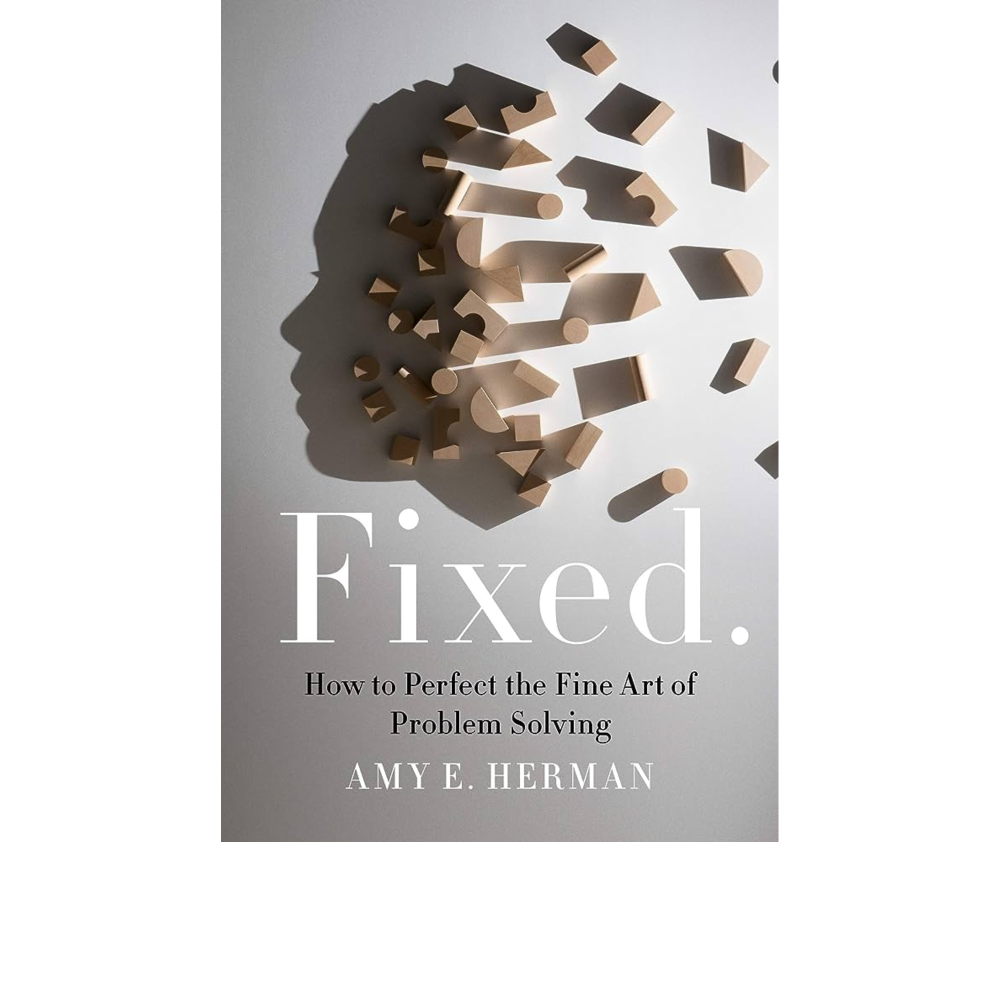Fixed provides a fresh set of tools that will help you kickstart your critical thinking skills and enable you to find solutions to some of your most intractable problems. The writer explains the artist’s use of the creative process and teaches you how to analyse paintings, sculpture, mixed media, photography, and contemporary art. By looking at these works more astutely, you hone your powers of perception and discover deep-seated truths about yourself that often prevent clear thinking and optimal decision-making. The book was written by Amy Herman and published on the 7th of December 2021.
HOW THIS BOOK HELPED US?
The book helped us understand the importance of setting deadlines while solving problems, and they give problem parameters, a vision for completion and a rationale. Also, the author taught us to take time and plan and think about what we’re to do and say, as we can not solve our problems with the same thinking we used when putting them into existence.
THE BOOK EXPLAINED UNDER 60 SECONDS
The book demonstrates a substantial paradigm shift for finding solutions; it also teaches us to see things differently, using art to challenge our default thinking and open up possibilities otherwise overlooked. Her unexpected, insightful, and often delightful methodology is sought after by leaders and professionals for whom failure is catastrophic.
TOP THREE QUOTES
- “Jumping right into solve-it mode without adequately considering a sticky situation’s scope, depth, and delicacy can sabotage the final results.”
- “We can’t effectively problem-solve if we don’t know ourselves and our minds.”
- “Problem-solving, like creating art, involves making a coherent narrative out of materials—or information—that one has gathered.”
BOOK NOTES AND SUMMARIES
Chapter one: Prep

Clean Your Lenses
Although science has helped us evolve past believing in crystal skeletons, we still suffer from extensive delusions today. People have delusions of grandeur, think they’re better, more thoughtful, or more generous than they are, and have no idea how others see them. Misconceptions are simply disconnects between what a person thinks about themselves and reality. In other words, a lack of self-awareness. And more than half of us are oppressed by this. Ninety-five per cent of people think they are self-aware, but in a real sense, it’s just 10 to 15 per cent. This is an age of unmatched information, yet we’re in the dark regarding ourselves. This is simply because we want to be.
People no longer get news from carefully curated and traditional sources like newspapers but rather graze the internet. This ability has offered the ultimate democratisation of information and also gave users the unique power of one being their own editor. With this total control, people would easily be inclined toward opinions that support their own. People often miscalculate situations because they’re blinded by their views and hopes and only see what they want. We all engage in selective truth-seeking because it makes us feel good. We like to be surrounded by people who cosign our beliefs and lifestyles.
Change Your Shoes
To problem-solve as artists do, you have to address perspective actively. You must consider it as a means of
Step outside yourself as a strategy for changing your physical and emotional vantage points. Perspective is something artists plan for, practice religiously, and constantly check to make sure they’re getting it right. The right attitude for problem-solving is speeding up at your own pace. But also, being in a rush to do what has to be done might only get you a solution if you take on these tasks prudently and thoughtfully. Awareness of and addressing perspective can help us understand almost any situation better. And change it. When you look for a different perspective, you will find it. Then keep looking. You can find more if you find one point of view you didn’t automatically consider. Changing your perspective, even slightly, can be an intimidating prospect because you need to figure out what you’ll uncover and how it might affect the system’s stability which serves some of us well. However, perspective can be challenging to see. Instead of looking at a situation straight on, noticing only what is familiar to you, try looking from another’s point of view. We can use this technique to assist us in problem-solving by consciously changing our perspective physically, emotionally, and intellectually.
Favourite quote of the chapter: “Delusions are simply disconnects between what a person thinks about themselves and reality. In other words, a lack of self-awareness. And the majority of us are afflicted.
Chapter two: Draft

Problem-solving involves making a coherent narrative out of materials or information that you have gathered. You may begin with only raw materials, but the process rapidly revolves and puts those materials together meaningfully. It’s the process of creating order from disorder. This is the stage where the artist begins drafting. Every discipline demands a specific drafting process, and the rough draft will be sharpened into final work. The method to organise and prioritise whatever information you’ve collected will be unique to your preference and problem. There is much to learn from how artists view information—specifically their focus. The ability to willingly shift your focus is more beneficial to an artist than skill.
Break It into Bite-Sized Pieces
Break down the project into manageable pieces to minimise distractions and focus more. Then find freedom in each component of the grand master plan. Many modern artists similarly approach their work, concentrating on the pieces while shaping the whole. Once you understand breaking down projects, the final result is a visual reminder that you can come out of any problem, individual or mutual. When you’re problem-solving, it can seem like you’re up against the impossible, but sometimes you can use the missing information and try to fix the issue. Some artists use this approach. They know that you’re constantly trying to make connections, even when the separate elements they present to you seem impossible to connect. They challenge you to make connections—and play with your need to understand—by carefully constructing a puzzling image that your mind struggles to resolve.
There is no ultimate way to organise or analyse information. Still, you can progress if you approach the process confidently, embrace baby steps at a time, and always look out for unknown or missing information. The progress later turns into promises that just might turn into a masterpiece.
Recognise Relationships and Red Herrings
Relationships can determine happiness, health, wealth, and even mortality rates. Since they’re the root cause of—but also the solution to—many of our problems. Art’s relationships between visual elements such as shape, colour, and form and design principles like symmetry and scale are everywhere. They, too, can be delicate, stormy, troubled, dreamy, and so on. You can analyse those relationships the same way you analyse the relationships among the pieces and players of your problems.
To navigate problems with relationships successfully, we must look at all the information objectively rather than trying to fish for facts that suit our desired solution. This takes time and clarity of thought; these are only sometimes readily available. It is work, but the results, in the form of grounded solutions, are well worth the effort.
Favourite quote of the chapter: “I try in vain to find something steady; nothing seems solid, everything eludes me, deceives me.”
Chapter three: Exhibit

For several reasons, things may turn out differently than you planned. But then you can’t ignore when things go wrong, even if it’s a project you loved.
Manage Contradictions
Our modern lives are populated with people and organisations that challenge our sanity and conscience with contradictory demands. That’s to say, corporations encourage employees to have a healthy work-life balance but require year-over-year improvements in several performance metrics. Contradiction also spills into our personal lives, as we’re bombarded with contrary opinions and facts daily. Contradictions can be disturbing, their blinding contrasts almost staring at us, daring us to make a move. Others, however, are more subtle and hard to pin down. When confronted with a contradiction, determine whether your feelings toward it are positive or negative, and then ask yourself why. You must know when you’re getting into denial to navigate it successfully. Checking to see if you’re coming from a place of positivity or negativity toward a problem can help you resolve it. Before you can straighten out a contradiction, you must be able to explain it to another person, preferably someone not present and without accessing the information, which ensures that your description is clear and complete.
Repair Mistakes with Gold
Many artists have used the “Kintsugi Philosophy” to repair their work. And in every case, the repair re-energises the object and results in a mesmerising new creation or even more beautiful than it was. Problem-solving often doesn’t stick because you need to include an acknowledgement of the problem itself in your solution. The best solutions recognise past failures and address how they will make amends.
It’s Never Too Late to Fix Something. Things can be fixed four days from now, in four years, or in four decades. Kintsugi reminds us to keep going and keep trying to solve our thorniest problems because it’s never too
late.
Don’t Be Afraid to Break Things. Finding the beauty in scars sometimes requires us to break things purposefully: expectations, traditions, and the way it’s always been done.
Favourite quote of the chapter: “Gratitude for survival has imbued my daily problem-solving abilities with a determination that did not exist before.”
HOW THIS BOOK CAN HELP SOFTWARE DEVELOPERS
“Fixed: How to Perfect the Fine Art of Problem-Solving” by Amy Herman is a book that can benefit software developers in several ways. The author’s approach is to teach problem-solving techniques by analysing works of art, which can help developers learn to think more creatively and critically. The book focuses on sharpening observation skills, identifying and solving problems, and developing an understanding of the importance of context. These skills can be applied to software development by helping developers to identify problems and potential solutions more efficiently and accurately. By studying works of art, developers can learn to pay attention to details, consider multiple perspectives, and approach problems from different angles. This book can help software developers improve their problem-solving skills and become more effective at their jobs.


